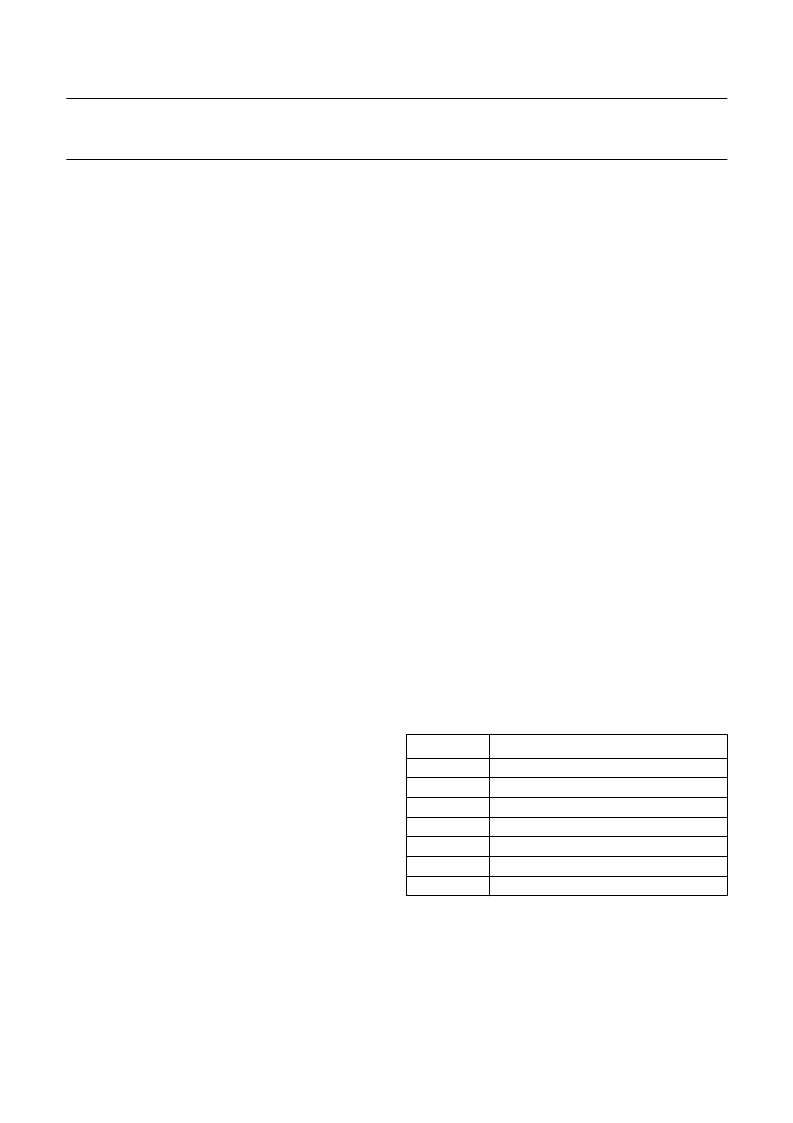- 您現(xiàn)在的位置:買賣IC網(wǎng) > PDF目錄382381 > PCE84C886 (NXP SEMICONDUCTORS) Microcontroller for monitor OSD and auto-sync applications PDF資料下載
參數(shù)資料
| 型號: | PCE84C886 |
| 廠商: | NXP SEMICONDUCTORS |
| 元件分類: | 微控制器/微處理器 |
| 英文描述: | Microcontroller for monitor OSD and auto-sync applications |
| 中文描述: | 8-BIT, MROM, 10 MHz, MICROCONTROLLER, PDIP42 |
| 封裝: | 0.600 INCH, PLASTIC, SDIP-42 |
| 文件頁數(shù): | 13/36頁 |
| 文件大小: | 168K |
| 代理商: | PCE84C886 |
第1頁第2頁第3頁第4頁第5頁第6頁第7頁第8頁第9頁第10頁第11頁第12頁當(dāng)前第13頁第14頁第15頁第16頁第17頁第18頁第19頁第20頁第21頁第22頁第23頁第24頁第25頁第26頁第27頁第28頁第29頁第30頁第31頁第32頁第33頁第34頁第35頁第36頁

1996 Feb 21
13
Philips Semiconductors
Objective specification
Microcontrollers for digital auto-sync and
VST TV controller applications
PCE84C486; PCE84C487
7.3
14-bit PWM output (PWM8)
The 14-bit PWM output can be used to generate the
Automatic Frequency Control (AFC) signal used in VST
applications.
PWM8 shares the same pin as Derivative Port line DP13.
Selection of the pin function as either a PWM output or as
a Derivative Port line is achieved using the PWM8E bit in
Register 22.
The Block diagram for the 14-bit PWM output is shown in
Fig.10 and comprises:
Two 7-bit latches: PWM8L (Register 18) and PWM8H
(Register 19)
14-bit data latch (PWMREG)
14-bit counter
Coarse pulse controller
Fine pulse controller
Mixer.
Data is loaded into the 14-bit data latch (PWMREG) from
the two 7-bit data latches (PWM8H and PWM8L) when
PWM8L is written to. The contents of PWMREG determine
the active time of the PWM8 output. The upper seven bits
of PWMREG are used by the coarse pulse controller and
determine the coarse pulse width; the lower seven bits are
used by the fine pulse controller and determine in which
subperiods fine pulses will be added. The outputs OUT1
and OUT2 of the coarse and fine pulse controllers are
‘ORED’ in the mixer to give the PWM8 output. The polarity
of the PWM8 output is programmable and is selected by
the P8LVL bit in Register 23.
As the 14-bit counter is clocked by
1
3
×
f
xtal
, the repetition
times of the coarse and fine pulse controllers may be
calculated as shown below.
Coarse controller repetition time:
Fine controller repetition time:
Figure 11 shows typical PWM8 outputs, with coarse
adjustment only, for different values held in PWM8H. Note
that the PWM8 coarse controller output is the same as the
7-bit PWM outputs except the polarity is reversed.
Figure 12 shows typical PWM8 outputs, with coarse and
fine adjustment, after the coarse and fine pulse controller
outputs have been ‘ORED’ by the mixer.
t
sub
f
xtal
384
=
t
r
f
xtal
49152
=
7.3.1
C
OARSE ADJUSTMENT
An active HIGH pulse is generated in every subperiod; the
pulse width being determined by the contents of PWM8H.
The coarse output (OUT1) is LOW at the start of each
subperiod and will remain LOW until the time
has elapsed. The output will
3 f
xtal
PWM8H
1
+
then go HIGH and remain HIGH until the start of the next
subperiod. The coarse pulse width may be calculated as
shown below.
7.3.2
F
INE ADJUSTMENT
Fine adjustment is achieved by generating an additional
pulse in specific subperiods. The pulse is added at the
start of the selected subperiod and has a pulse width of
3/f
xtal
. The contents of PWM8L determine in which
subperiods a fine pulse will be added. It is the logic 0 state
of the value held in PWM8L that actually selects the
subperiods. When more than one bit is a logic 0 then the
subperiods selected will be a combination of those
subperiods specified in Table 3. For example, if
PWM8L = 111 1010 then this is a combination of:
PWM8L = 111 1110: subperiod 64 and
PWM8L = 111 1011: subperiods 16, 48, 80 and 112.
Pulses will be added in subperiods 16, 48, 64, 80 and 112.
This example is illustrated in Fig.13.
When PWM8L holds 111 1111 fine adjustment is inhibited
and the PWM8 output is determined only by the contents
of PWM8H.
Table 3
Additional pulse distribution
PWM8L
ADDITIONAL PULSE IN SUBPERIOD
111 111
0
111 11
0
1
111 1
0
11
111
0
111
11
0
1111
1
0
1 1111
0
11 1111
64
32 and 96
16, 48, 80 and 112
8, 24, 40, 56, 72, 88, 104 and 120
4, 12, 20, 28, 36, 44, 52...116 and 124
2, 6, 10, 14, 18, 22, 26, 30...122 and 126
1, 3, 5, 7, 9, 11, 13, 15, 17...125 and 127
(
)
×
[
]
Pulse duration
127
PWM8H
–
(
)
xtal
f
×
=
相關(guān)PDF資料 |
PDF描述 |
|---|---|
| PCF1000 | Analog IC |
| PCF600 | Analog IC |
| PCF1174C | 4-digit static LCD car clock |
| PCF1174CT | 4-digit static LCD car clock |
| PCF1174CU | 4-digit static LCD car clock |
相關(guān)代理商/技術(shù)參數(shù) |
參數(shù)描述 |
|---|---|
| PCEA02 | 制造商:ADAM-TECH 制造商全稱:Adam Technologies, Inc. 功能描述:.100&.156 RECEPTACLE WITH BOARD HOOKS |
| PCE-A-05 | 制造商:ADAM-TECH 制造商全稱:Adam Technologies, Inc. 功能描述:.100 RECEPTACLE WITH BOARD HOOKS |
| PCEA10 | 制造商:ADAM-TECH 制造商全稱:Adam Technologies, Inc. 功能描述:.100&.156 RECEPTACLE WITH BOARD HOOKS |
| PCEA20 | 制造商:ADAM-TECH 制造商全稱:Adam Technologies, Inc. 功能描述:.100&.156 RECEPTACLE WITH BOARD HOOKS |
| PCEB02 | 制造商:ADAM-TECH 制造商全稱:Adam Technologies, Inc. 功能描述:.100&.156 RECEPTACLE WITH BOARD HOOKS |
發(fā)布緊急采購,3分鐘左右您將得到回復(fù)。